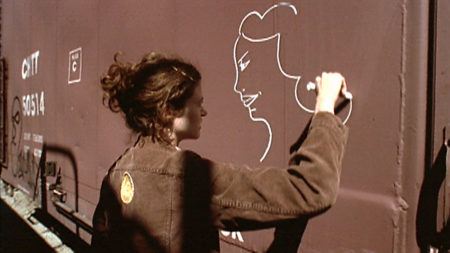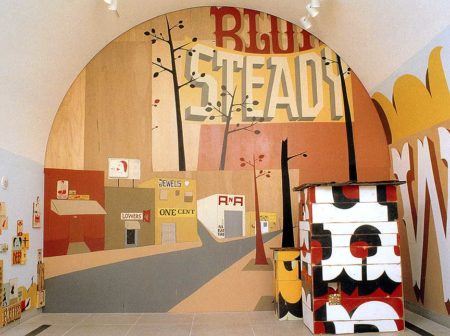Continue playing
(Time remaining: )
Play from beginning
Continue playing "{{ controller.videos[controller.getVideo(controller.currentVideo)].segmentParentTitle}}"
{{controller.videos[controller.getVideo(controller.currentVideo)].title}} has ended.
HeroinesMargaret Kilgallen
Filmed in San Francisco in 2000, Margaret Kilgallen (1967-2001) discusses the female figures she incorporated into many of her paintings and graffiti tags. Loosely based on women she discovered while listening to folk records, watching buck dance videos, or reading about the history of swimming, Kilgallen painted her heroines to inspire others and to change how society looks at women.
Three of Kilgallen’s heroines—Matokie Slaughter, Algia Mae Hinton, and Fanny Durack—are shown and heard through archival video, images, and audio recordings. Kilgallen is shown tagging train cars with her husband, artist Barry McGee, in a Bay Area rail yard and painting in her studio at UC Berkeley.
More information and creditsCredits
Producer: Ian Forster. Consulting Producer: Wesley Miller & Nick Ravich. Interview: Susan Sollins. Camera: Bob Elfstrom. Sound: Ray Day & Doug Dunderdale. Editor: Morgan Riles. Artwork Courtesy: Margaret Kilgallen. Archival Media Courtesy: Berea College, Alice Gerrard, Mitchell Library, State Library of NSW, Australia, The National Museum of Australia, North Carolina Folklife Program, NC Arts Council, Mike Seeger, Smithsonian Folkways Recordings, Lightnin’ Wells & Wilson Library, The University of North Carolina at Chapel Hill. Photography: Mary Ann McDonald. Special Thanks: Fanny Durack, Algia Mae Hinton, Barry McGee & Matokie Slaughter. Theme Music: Peter Foley.
Closed captionsAvailable in English, German, Romanian, Italian, Japanese, Korean, Chinese, Italian
Through the Art21 Translation Project, multilingual audiences from around the globe can contribute translations, making Art21 films more accessible worldwide. Translate this video now.
Interested in showing this film in an exhibition or public screening? To license this video please visit Licensing & Reproduction.
Early experiences as a librarian and bookbinder contributed to Margaret Kilgallen’s encyclopedic knowledge of signs, drawn from American folk tradition, printmaking, and letterpress. Painting directly on the wall, Kilgallen created room-size murals that recall a time when personal craft and handmade signs were the dominant aesthetic. Strong, independent women—walking, surfing, fighting, and biking—are featured prominently in the artist’s compositions. Kilgallen had a love of “things that show the evidence of the human hand.” She died in June 2001 in San Francisco, where she lived with her husband, Barry McGee.
“I like to paint images of women who I find inspiring, and I don’t like to choose people that everybody knows. I like to choose people that just do small things, and yet somehow hit me in my heart.”
Margaret Kilgallen
Graffiti & Street Art
Barry McGee




